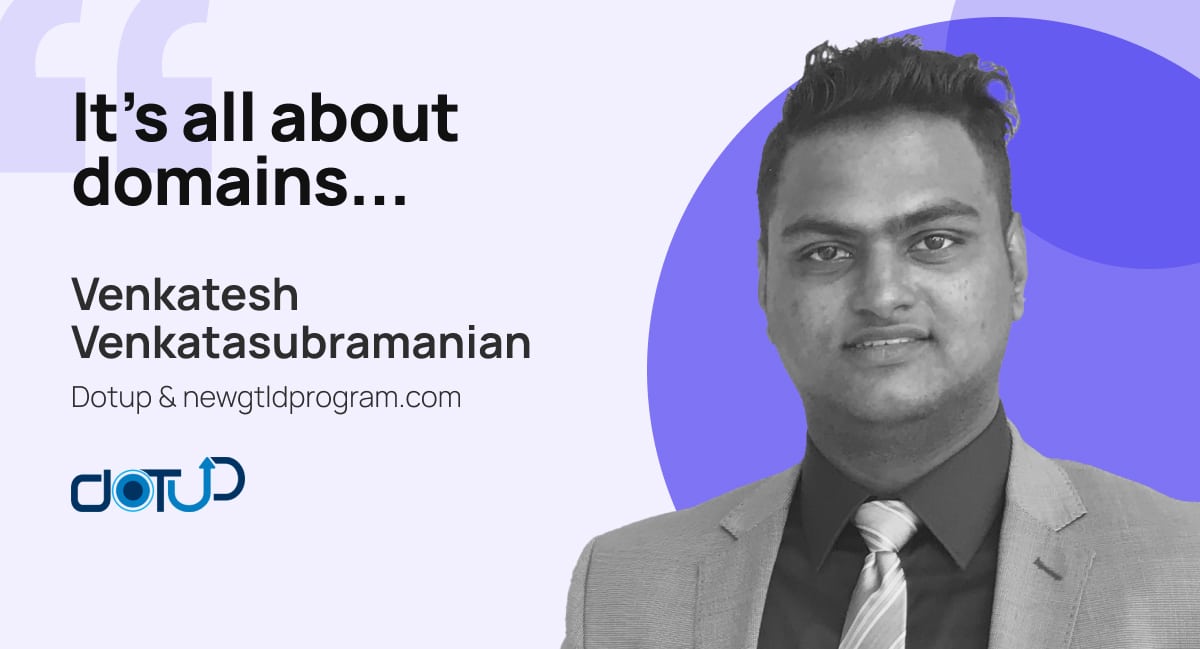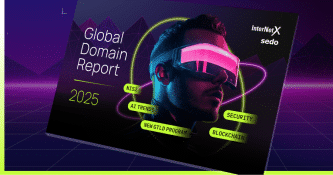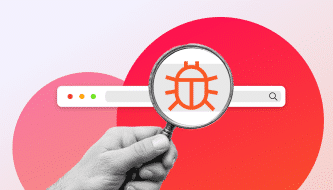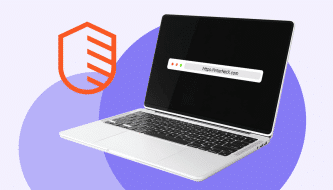
It’s all about domains with… Venkatesh Venkatasubramanian

The next gTLD round is coming in 2026 – are you ready? Get practical insights for your new gTLD application.
Published by

Simone Catania
Date
The launch of new gTLDs has reshaped the internet’s naming landscape, offering businesses, communities, and innovators a chance to define unique online identities beyond traditional .com or .org. Since ICANN opened the first new gTLD round in 2012, hundreds of extensions have entered the market, fueling creativity and competition. Now, anticipation is building for the next gTLD program 2026. This upcoming round promises vast opportunities but also presents a highly complex application process—complete with technical, financial, and compliance hurdles that demand careful preparation.
In this interview, we look at the new gTLD 2026’s application process, shedding light on the costs, and the expertise required. Guiding us through these intricacies is Venkatesh Venkatasubramanian, Director and Product Manager at Dotup ICANN Accreditation Consultancy. With over eight years of hands-on experience in ICANN compliance and registrar accreditation, Venkatesh has successfully supported more than a dozen registrars worldwide in securing accreditation and building scalable platforms. His deep expertise makes him the ideal voice to discuss what lies ahead.
Read on for practical insights to help shape your strategy for the next wave of digital identities with the new gTLD program 2026.

1What were the key successes and failures in 2012, and how are those lessons shaping ICANN’s approach to the new gTLD program 2026?
The 2012 round was ambitious — a creative leap forward — but it exposed a gap between vision and execution. Many brands applied defensively, guided by lawyers rather than strategists, and had no clear plan for use. Roughly 20% later returned their TLDs, while others simply parked them. Even those that launched, like Barclays, struggled: search engines weren’t ready, visibility dropped, and they reverted to .com.
Yet there were successes. E. Leclerc, CERN, and SBI (State Bank of India) executed smooth transitions, and Japanese giants like Canon, Toyota, and Honda did the same, thanks to well-planned migrations covering DNS, SEO, and a whole infrastructure around it.
Today, conditions are better. Google fully supports dotBrands, infrastructure is mature, and case studies exist. I work with brands not just on applications but also long-term adoption roadmaps — proving that what once felt experimental is now viable.
On the commercial side, the lesson was clear: owning a TLD doesn’t guarantee revenue. The winners were operators with a defined niche and strong go-to-market plans, not those chasing volume. That principle will be even more important in the new gTLD program 2026, where hype around AI, Web3, and Fintech may fuel applications — but lasting success will come from solving real problems and serving specific communities.
ICANN has learned as well. The 2026 round is more structured, transparent, and shaped by what worked — and what didn’t — the first time.
2Why is now the right time to launch a round of new gTLDs, and what opportunities should stakeholders be watching?
In 2012, the market wasn’t ready: mobile-first was new, cloud adoption was early, and cybersecurity wasn’t yet a board-level issue. Today, all that has changed.
The internet is saturated with fraud and phishing. A dotBrand offers a closed, authenticated namespace that attackers can’t easily mimic. That’s why banks like SBI and groups like BNP Paribas now treat dotBrands as a core security strategy, not a gimmick.
The ecosystem has also matured: search engines support dotBrands, DNSSEC adoption is up, and registry technology is far more advanced. Migration is no longer risky — it’s structured, with clear playbooks.
Opportunities extend beyond vanity. Enterprises can future-proof digital identity, governments can assert digital sovereignty, and niche operators can capture fast-growing verticals. Expect strong activity in AI, Fintech, Healthtech, and local languages — areas where trust and identity matter most.
3What new challenges will applicants face in the new gTLD round 2026 compared to 2012, and how should they prepare?
Three stand out:
- Technical readiness — ICANN now demands robust partnerships with Registry Service Providers (RSPs) to guarantee DNS and domain security, escrow, abuse reporting, and compliance. Without a credible RSP, applications will fail.
- Internal alignment — new gTLD success requires buy-in across marketing, IT, legal, and leadership. In 2012 many treated TLDs as side projects; in 2026 they need adoption roadmaps covering SEO, customer communication, and asset migration.
- Competition for strings — Contention will be fierce, especially around certain tech and niche areas. With private auctions banned, resolution depends on ICANN’s processes, requiring stronger business cases.
Bottom line: Partner early with a capable RSP, align internally (and bring in external experts where needed), and choose strings strategically. In 2012 the challenge was getting in; in 2026 it will be proving you belong.
Preparation comes down to three things:
- Partner early with the right RSP to guarantee technical strength.
- Build an internal task force and bring in external experts where needed.
- Choose your string strategically, with ICANN’s contention rules in mind.
In 2012, the challenge was simply getting in. In 2026, the challenge will be proving you belong.
4Have end-users and businesses truly embraced the potential of new gTLDs? If not, what could the next round do to accelerate adoption?
Adoption lagged in 2012. Many brands applied defensively, never activated their TLDs, and consumers stayed loyal to .com or ccTLDs. Without visible use cases, habits never changed.
That’s shifting. SBI in India uses its dotBrand to reduce fraud while serving millions of secure logins. E.Leclerc leverages its TLD for launches and loyalty programs. Microsoft builds entire ecosystems on support.microsoft and surface.microsoft, creating trust and authenticity. These examples prove the model works.
Research backs this up: brands that activated dotBrands reported higher trust, stronger engagement, and greater control. With security now a board-level concern, phishing losses in the billions, and consumers skeptical of unknown URLs, dotBrands offer clarity — login.brand leaves no doubt.
ICANN has also improved the framework: stronger RSP ecosystems, clearer policies, and full SEO support reduce risk. Combined with today’s preference for short, memorable names, dotBrands are shifting from “experimental” to “essential.”
5What are the key steps or milestones applicants should focus on to ensure success?
Success depends on preparation, broken into milestones:
- Strategic clarity — Define why you’re applying: security, marketing, customer experience, or community.
- Right partners — Lock in a credible RSP early; align internal teams across marketing, IT, and legal; and consider external consultants.
- Document readiness — ICANN requires extensive disclosures (financials, governance, abuse policies, technical specs). Gathering these takes time.
- Risk planning — Be ready for contention and ICANN’s resolution mechanisms. Choose defensible strings.
- Post-application roadmap — Launch planning matters as much as applying. Map migrations, SEO, and customer communication.
6What key elements of the Applicant Guidebook should not be overlooked?
The Application Guidebook (AGB) is the blueprint. In 2012, many skimmed it and paid the price. Applicants should pay close attention to:
- Financials — ICANN wants proof of stability, not just cash on hand.
- Technical requirements — DNS uptime, DNSSEC, escrow, abuse handling — all mandatory. Without a strong RSP, you won’t pass.
- String rules — Trademarks, geographic names, and restricted terms all carry conditions. Ignoring them invites objections.
Treat the Guidebook as a manual for the new gTLD program 2026, not red tape. Respect it, and the process becomes far smoother.
7The application fee is often seen as one of the biggest hurdles. What costs should applicants expect in this round and how should they plan their budgets accordingly?
The headline number is clear: ICANN’s evaluation fee is $227,000 per string — the price of entry. Refunds exist if you withdraw early, but serious applicants should treat the full amount as non-refundable. That’s only the start. Some applications carry extra charges — for example, Brand Eligibility Evaluations under Spec 13, or community and geographic reviews.
Then there are objections. Each comes with filing and panel fees, paid by both parties. In 2012, a single Legal Rights Objection could cost $10k just to start, with panel costs escalating. Expect the same this time. If your string is attractive or close to existing rights, assume you’ll face at least one.
Contention sets are another wildcard. Private auctions are no longer allowed; ICANN’s Auction of Last Resort is now the path. That can easily become your biggest expense — not technically a “fee,” but a cost you must prepare for.
Once delegated, recurring registry fees kick in: about $25,000 per year plus ~$0.25 per domain, along with TMCH access and claims fees during launch.
Beyond ICANN’s invoices, operations and compliance add weight. You’ll need a Registry Service Provider (RSP) for DNS uptime, DNSSEC, escrow, abuse reporting, and SLAs — often the largest ongoing expense. Add data escrow, audits, reporting, and the Continued Operations Instrument (COI) for continuity in case of failure.
Don’t overlook the human side: legal support for agreements and objections, admin resources for background checks, and program management for ICANN clarifications. Open registries must also budget for marketing, registrar onboarding, and large-scale domain abuse handling. DotBrands need multi-year adoption plans — SEO, redirects, customer communication, and internal migrations.
Rule of thumb: budget at least 2x the ICANN fee to reach delegation, and 3x if contention is likely, plus 18–24 months of operating costs.
The $227k buys your ticket in. The additional reserves — for Spec 13, objections, contention, RSP, compliance, COI, legal, and launch — are what keep you in the game and make your TLD valuable. Plan those line items from day one to avoid nasty surprises and rushed decisions.
New gTLD application & ongoing costs (2026 Round)
| Category | Cost / Range | Notes |
| ICANN evaluation fee | $227,000 per string | Base fee; refunds possible if withdrawn early, but treat as non-refundable. |
| Additional evaluation fees | Varies (~$5k–$50k) | Spec 13 (dotBrand), community, or geographic applications may trigger extra charges. |
| Objections | ~$10,000+ per party (filing) | Legal Rights, Community, or String Confusion objections; panel fees escalate quickly. |
| Contention sets | ICANN Auction of Last Resort (no cap) | Private auctions banned; auctions can exceed the base fee many times over. |
| Annual registry fee | ~$25,000 fixed + $0.25 per domain | Paid annually to ICANN after delegation; subject to slight uplifts. |
| Trademark Clearinghouse (TMCH) | Access + per-transaction fees | Applies during Sunrise/Claims periods. |
| Registry Service Provider (RSP) | Typically largest ongoing cost | Covers DNS uptime, DNSSEC, escrow, abuse handling, SLAs, reporting. |
| Compliance & COI | Varies | Data escrow, audits, reporting, Continued Operations Instrument (safety net). |
| Legal & administrative | Varies (often 6–7 figures total) | Legal drafting, objections, Registry Agreement, background checks, ICANN clarifications. |
| Program/Policy management | Varies | Internal resources or external consultants to coordinate adoption and compliance. |
| Marketing & adoption | Varies (high for open TLDs) | Registrar onboarding, customer comms, abuse management at scale. |
| dotBrand adoption | Multi-year roadmap | SEO, redirects, internal migrations, customer education.
|
8How do you see new gTLDs evolving in 2026, and what metrics will best measure their success?
In 2012, success was measured by registration numbers — a flawed metric. Some TLDs grew quickly on promotions but collapsed just as fast, while niche TLDs with loyal bases thrived. The strongest TLDs won’t just be big; they’ll be trusted, relevant, and resilient.
In 2026, success will be measured by:
- Usage and integration — Are dotBrands deployed in customer-facing ways?
- Retention — Renewal rates and engaged user bases matter more than raw volume.
- Trust and security — Low abuse levels will distinguish credible operators.
- Innovation — New naming models, identity integrations, and adoption by mainstream players.









